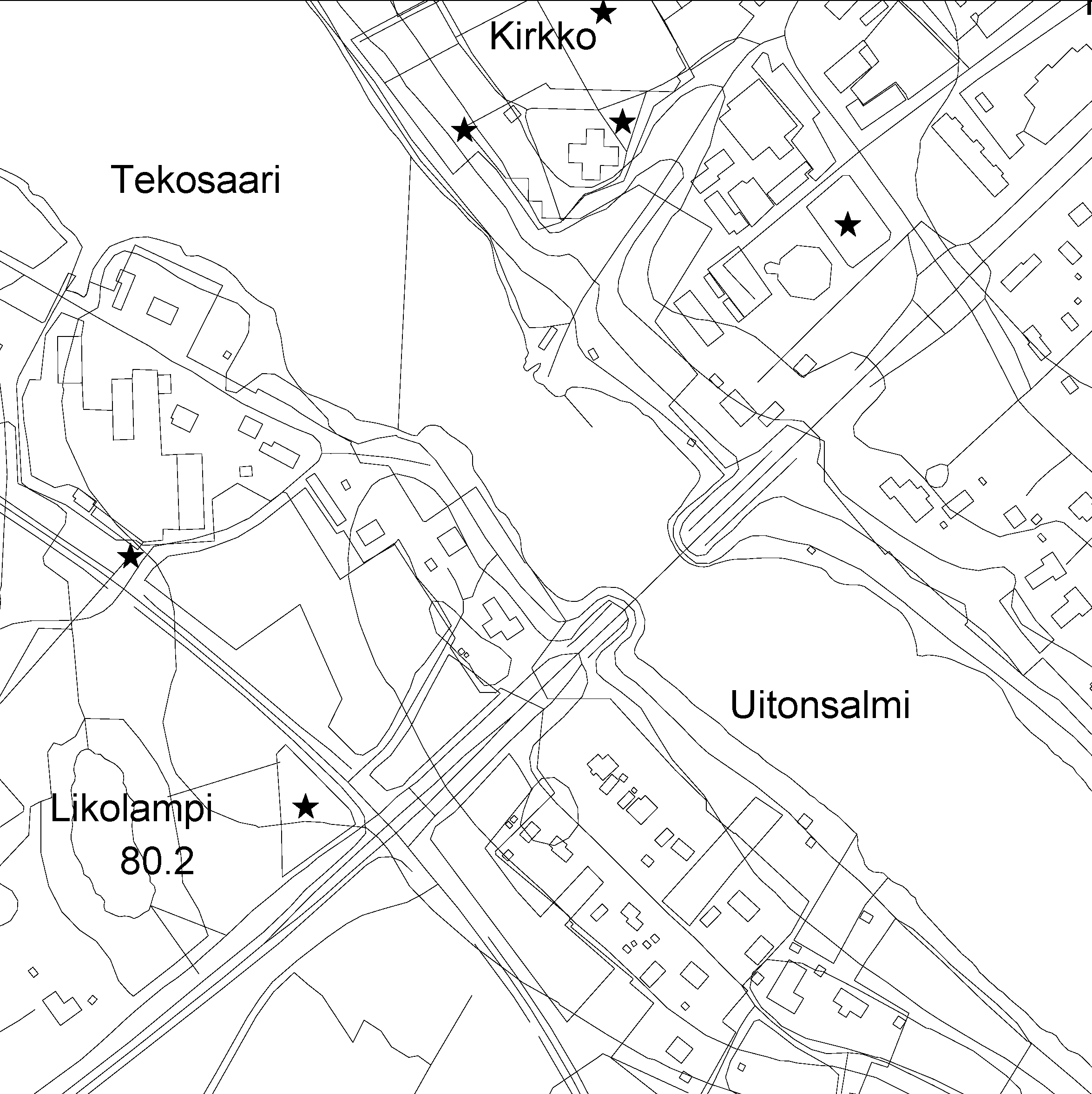GeoPackage
Type of resources
Topics
Keywords
Contact for the resource
Provided by
Formats
Representation types
Update frequencies
Scale
-
Agricultural parcel containing spatial data The agricultural parcels are a year-by-year data set containing the agricultural parcels in the annual aid application. A agricultural parcel is defined as a continuous area of a single reference parcel where a single crop, a mixture of crops or a mixture of crops is grown, set aside or used for a specific purpose. A reference parcel may have one or more agricultural parcels. A agricultural parcel may belong to only one reference parcel. The boundaries of the agricultural parcels, and hence their areas, may vary from year to year within the reference plot. The aim of the definition of valuable data sets (EU) 2023/138 has been to ensure that the most socially potential public data are reusable. The Food Authority is concerned with the theme Spatial data: reference parcels and agricultural parcels From the 2023 data onwards, the Food Authority will add attribute information to the published data as follows: Agricultural parcel containing spatial data - Organic production New field in the data set LUOMUVILJELY = Organic production: 1=absent or 0=no More information: https://www.ruokavirasto.fi/globalassets/tuet/maatalous/oppaat/hakuoppaat/peltotukiopas/peltotukien-hakuopas-2024.pdf
-
Agricultural land is the area of arable land (AL), permanent grassland (PG) and permanent crops (PC). Arable land is land cultivated for crop production or fallow land available for cultivation. Permanent grassland Permanent grassland is the area used to grow grasses or other herbaceous forage crops that have been on the same site for more than 5 years, either by self-regulation or by sowing. Permanent grassland may be arable land or natural pasture and meadow. Permanent grassland may not contain more than 50 trees per hectare in a scattered pattern. Trees are considered to be single- or multi-trunked trees and woody shrubs of at least four metres in height. Shrubs of all sizes are also considered as trees. Trees in windbreaks are not counted in the tree count. Deciduous bushes suitable for feeding farm animals and deciduous tree seedlings may be grown on the area if they cover less than half of the area of the eligible plot. More than half (50 %) of the area of the plot must be grass and forage. This requirement also applies to parcels of permanent grassland with trees or deciduous shrubs or both. Permanent crops Permanent crops are crops which are not part of the crop rotation, which are grown for at least 5 years and which produce a repeated harvest. These include fruit trees, berry bushes and ornamental plants. More information: https://www.ruokavirasto.fi/globalassets/tuet/maatalous/oppaat/hakuoppaat/peltotukiopas/maatalousmaa-2024.pdf
-
Maatalousmaalla tarkoitetaan pellon (AL), pysyvän nurmen (PG) ja pysyvien kasvien (PC) alaa. Pelto on kasvien tuotantoa varten viljeltyä maata tai viljelyyn käytettävissä olevaa kesantomaata. Pysyvä nurmi Pysyvää nurmea on ala, jota käytetään yli 5 vuotta samalla paikalla olleiden heinäkasvien tai muiden nurmirehukasvien kasvattamiseen joko itseuudistuvasti tai kylvämällä. Pysyvä nurmi voi olla maankäyttölajiltaan peltoa tai luonnonlaidunta ja -niittyä. Pysyvällä nurmella saa kasvaa hajanaisesti enintään 50 puuta hehtaarilla. Puuksi katsotaan vähintään neljän metrin korkuiset yksi- tai monirunkoiset puut ja puumaiset pensaat. Myös kaiken kokoiset katajat katsotaan puiksi. Tuulensuojaistutusten puita ei oteta huomioon puiden määrässä. Alalla saa kasvaa tuotantoeläinten ravinnoksi soveltuvia lehtipensaita ja lehtipuiden taimia, jos niitä on alle puolet tukikelpoisen kasvulohkon pinta-alasta. Yli puolella (50 %) kasvulohkon pinta-alasta on oltava heinä- ja nurmirehukasveja. Vaatimus koskee myös niitä pysyvän nurmen lohkoja, joilla on puita tai lehtipensaita tai molempia. Pysyvät kasvit Pysyvillä kasveilla tarkoitetaan viljelykiertoon kuulumattomia kasveja, joita kasvatetaan vähintään 5 vuoden ajan ja joista saadaan toistuvaa satoa. Näitä kasveja ovat esimerkiksi hedelmäpuut, marjapensaat ja koristekasvit. Lisätietoa: https://www.ruokavirasto.fi/tuet/maatalous/oppaat/hakuoppaat/hakuoppaat/peltotukien-hakuopas/peltotukien-hakuopas-2023/
-
Conditionality refers to the basic requirements that farmers' payments are conditional upon. Conditionality requirements are the baseline level for which you do not receive a separate payment. Aid is only granted for activities that go beyond the conditionality requirements. Conditionality consists of GAEC, statutory management requirements and social conditionality. Statutory management requirements relate to environmental issues, public health, i.e. food and feed safety, plant health and animal health and welfare. All conditionality requirements are described in this guide. When you apply for farmer payments, you agree to comply with the conditionality requirements. A landscape feature can be a tree, group of trees, transplanted block or other similar natural feature that is protected for its beauty, rarity, landscape significance, scientific value or other similar reason. Qualifying landscape features are sites protected under Article 95 of the Nature Conservation Act (9/2023) and located within a base parcel, on the periphery of a base parcel or in the area between adjacent base parcels. Protected sites must always be preserved and must not be damaged or removed. If a protected landscape feature is located on an area of 0,2 ha or less, it may be included in the area of the base parcel. If you wish to include a protected site in the eligible area, please declare the sites on the Food Agency's form 442 when applying for arable aid. The area of a landscape feature will only become part of the eligible area of the base parcel in the year following the submission of the declaration. Who makes conservation decisions on sites? If the site to be protected is located on private land, the decision to protect the site is taken by the municipality's environmental protection authority. The municipality is also responsible for marking the site on the land. On private land, protection is only granted on application or with the consent of the landowner. On application by the owner or on a proposal from the ELY Centre, the municipality may terminate the protection of a landscape feature if there are no longer grounds for protecting it or if the protection prevents the implementation of a project or plan of public interest. The application must be accompanied by the opinion of the ELY Centre. If the matter has been initiated on the basis of a proposal from the ELY Centre, the owner of the site must be given the opportunity to be heard. For more information: https://www.ruokavirasto.fi/tuet/maatalous/perusehdot/ehdollisuus/ehdollisuuden-opas/ehdollisuuden-opas-2025/
-
Säilytettävät maisemapiirteet Viljelijätukien ehtona on täydentävien ehtojen noudattaminen. Täydentävien ehtojen hyvän maatalouden ja ympäristön vaatimuksiin kuuluu velvollisuus säilyttää maisemapiirteitä. Euroopan parlamentin ja neuvoston asetuksen (EU) N:o 1306/2013 liitteen II vaatimuksiin sisältyy maisemapiirteiden säilyttäminen. Kansallisesti maisemapiirteiden säilyttämisestä säädetään valtioneuvoston asetuksessa täydentävien ehtojen hyvän maatalouden ja ympäristön vaatimuksista 4/2015 (muutoksineen). Tuenhakijan on säilytettävä maatalousmaalla olevan peruslohkon sisällä tai peruslohkon pientareella tai toisiinsa rajoittuvien peruslohkojen välisellä alueella olevat maisemapiirteet. Maisemapiirteiden säilyttämistä valvotaan täydentävien ehtojen valvonnassa. Täydentävien ehtojen mukaan säilytettäviä maisemapiirteitä ovat mm. puu, puuryhmä, siirtolohkare tai vastaava luonnonmuodostuma (≤ 0,2 ha), joka on määrätty rahoitetuksi luonnonmuistomerkiksi luonnonsuojelulain (1096/1996) 23 §:n tai Ahvenanmaalla maakuntalain (ÅFS 82/1998) 6 §:ssä perusteella. Maisemapiirteitä ovat myös avointa maisemaa hallitsevat suuret yksittäiset puut ja puuryhmät, joka on suojeltu luontotyyppi (≤ 0,2 ha) luonnonsuojelulain (1096/1996) 29 §:n 1 momentin 9 kohdan tai Ahvenanmaalla luonnonsuojelusta annetun maakunta-asetuksen (ÅFS 113/1998) 5 §:n 8 kohdan perusteella. Luonnonmuistomerkkien suojelupäätöksiä tekevät kuntien ympäristöviranomaiset. Luonnonsuojelulain mukaisten yksittäispuiden sekä puuryhmien suojelu on elinkeino-, liikenne ja ympäristö keskusten (ELY-keskusten) vastuulla. Ahvenanmaalla luonnonmuistomerkkien ja luontotyyppien suojelusta vastaa maakuntahallitus. Maisemapiirteen ilmoittaminen tukikelpoiseen alaan Voit ilmoittaa maisemapiirteen mukaan tukikelpoiseen alaan lomakkeella 442 (https://www.ruokavirasto.fi/globalassets/tietoa-meista/asiointi/oppaat-ja-lomakkeet/viljelijat/tuet-ja-rahoitus/lomakkeet/442.pdf). Maisemapiirteet voidaan hyväksyä tukikelpoiseen alaan kaikissa pinta-alaan perustuvissa viljelijätuissa (esim. perustuki ja ympäristökorvaus). Tukikelpoisiksi voidaan katsoa enintään 0,2 ha kokoiset maisemapiirteet. Tukikelpoiseksi ei voi saada yli 0,2 hehtaarin kokoisia suojelukohteita, eikä esim. vuokrasopimuksen ulkopuolelle jääviä alueita. Maisemapiirteet voidaan hyväksyä peruslohkon kokonaisalaan, mikäli ne sijaitsevat peltolohkon sisällä, peltolohkon pientareella tai toisiinsa rajoittuvien peltolohkojen välisellä alueella. Maisemapiirteen ala tulee osaksi peruslohkon tukikelpoista alaa vasta ilmoituksen jättämistä seuraavana vuonna. Maisemapiirteen pinta-ala liitetään siihen kasvulohkoon, joka on kohteen välittömässä läheisyydessä. Lohkokohtaisissa muistiinpanoissa viljelijä tekee maisemapiirteestä oman lannoituslohkon, jolle ei saa levittää lannoitteita. Lisätietoa: https://ruokavirasto.mobiezine.fi/zine/618/pdf ja https://www.ruokavirasto.fi/tuet/maatalous/perusehdot/ehdollisuus/ehdollisuuden-opas/ehdollisuuden-opas-2023/
-
Kasvulohkot ovat vuosikohtainen aineisto, joka sisältää vuosittaisella tukihakemuksilla olevat kasvulohkot. Kasvulohkolla tarkoitetaan yhteen peruslohkoon kuuluvaa yhtenäistä aluetta, jossa kasvatetaan yhtä kasvilajia, useamman kasvilajin seosta tai jota kesannoidaan tai joka on erityiskäytössä. Yhdellä peruslohkolla voi olla yksi tai useampia kasvulohkoja. Kasvulohko voi kuulua vain yhteen peruslohkoon. Kasvulohkojen rajat ja samalla niiden pinta-alat voivat vaihdella peruslohkon sisällä vuosittain. Arvokkaiden tietoaineistojen (EU) 2023/138 määrittelyn tavoitteena on ollut varmistaa, että yhteiskunnallisesti potentiaalisimmat julkiset tiedot ovat uudelleen käytettävissä. Ruokavirastoa koskettaa teema paikkatieto: Viitelohkot ja Viljelylohkot Ruokavirasto lisää vuoden 2023 tiedoista alkaen ominaisuustietoja julkaistaviin aineistoihin seuraavasti: Paikkatietoa sisältävä kasvulohko - Luonnonmukainen tuotanto Aineistossa uusi kenttä LUOMUVILJELY: 1=kyllä tai 0=ei Lisätietoa: https://www.ruokavirasto.fi/tuet/maatalous/oppaat/hakuoppaat/hakuoppaat/peltotukien-hakuopas/peltotukien-hakuopas-2023/
-
Field parcel register The field parcel register is an annual file containing the reference parcels covered by the annual aid application. A reference parcel is a geographically homogeneous area of land cultivated and owned or managed by an individual applicant (excluding commonly used land) and bounded by a municipal boundary, a property boundary, a subsidy or contract area boundary, a watercourse, a district or river, a road, a forest or other similar boundary. A homogeneous area in terms of geography, eligibility and type of land use owned by an aid applicant is a single reference parcel, even if it is made up of several separate registered parcels owned by the applicant. The aim of the definition of valuable data (EU) 2023/138 has been to ensure that the most socially potential public data are re-available. The Food Authority is concerned with the theme of spatial data: reference parcels and agricultural parcels From 2023 onwards, the Food Authority will add attributes to the published data as follows: Field parcel register - Organic production - Slope, ha (Sloping areas in base parcels with a slope of more than 15% in mainland Finland and more than 10% in Åland). - Groundwater area, ha - Natura area, ha - Buffer stripping requirement (metres), m The following new fields are included in the data: LUOMUVILJELY = Organic production: 1=absent or 0=no KALTEVA_ALA = SLOPE_AREA: Sloping areas in the base parcel. Slope in mainland Finland over 15 % and in Åland over 10 %, ha POHJAVESI_ALA = SHOREWATER_AREA: ha NATURA_ALA = NATURA_AREA: ha SUOJAKAISTA_M: Bufferstrip requirement (on parcel) , m. More information at: https://www.ruokavirasto.fi/globalassets/tuet/maatalous/oppaat/hakuoppaat/peltotukiopas/peltotukien-hakuopas-2024.pdf
-
-
-

The Topographic database is a dataset depicting the terrain of all of Finland. The key objects in the Topographic database are the road network, buildings and constructions, administrative borders, geographic names, land use, waterways and elevation. Aerial photographs, scanning data and data provided by other data providers are utilised in updating the Topographic database. The updating is done in close cooperation with the municipalities. Field checks in the terrain are also needed to some extent, mostly as regards the classification of features. The topographic database is used in the production of other map products and in various optimisation tasks. The product belongs to the open data of the National Land Survey of Finland.
 Paikkatietohakemisto
Paikkatietohakemisto